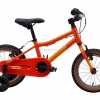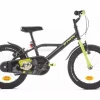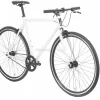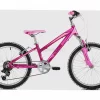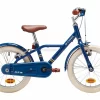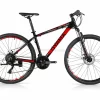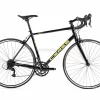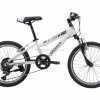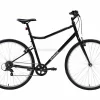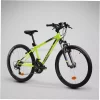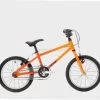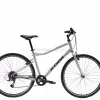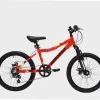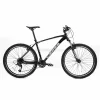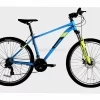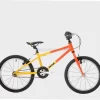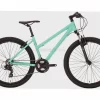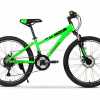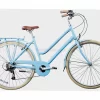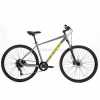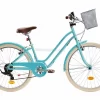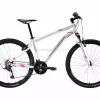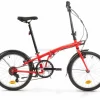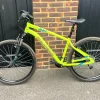Cheap Bikes
Hand selected online bike deals with substantial discounts
Order: Cheapest Prices | Biggest Savings
Welcome to my Sale Bikes section!
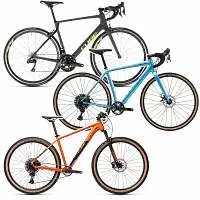
Here you'll see every cheap bike deal I found, all neatly organised into sections, enabling you to save money on your dream bike!
By using the term cheap bikes, what I'm referring to is discounted prices, and not solely listing bikes at the lower end of the market. I publish offers on models from £200 to £10K, and what they have in common is large savings. The vast majority of bikes for sale here have at least 20% off RRP, and are searchable by both type and size. Unless otherwise stated, all of the bikes are from UK retailers and prices quoted are in £GBP.
I've provided as many details on each bike deal to help you make an informed decision: Size, Colour, Frame type and material, Type of Brakes, Number of Gears, Wheel Diameter, Number of Chainrings and Weight (where possible), as well as Gender, Retailer and Brand Name. Also included is a full manufacturer's description of the bike, in addition to a high resolution photo.
Finally, as bikes are relatively bulky and heavy when compared to other purchases, where possible I've provided a guide to shipping costs. Typically this ranges between Free to £20, although some shops offer a priority bike building service for those in a hurry. For the rest of you, please note that as bikes have to be both built and thoroughly checked by mechanics prior to dispatch, delivery timescales will usually be longer than regular online cycling orders.
But which type of bike should you go for?
This largely depends on the type of riding you wish to do. Below I've outlined the main different categories of bikes listed on my website, with their strengths and weaknesses, together with any factors you should bear in mind prior to purchase.
Road Bikes
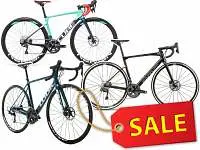
Large savings for UK roadies!
As the name suggests, these road bikes are ridden exclusively on smooth tarmac. They're lightweight, fast and stiff, resulting in very efficient pedalling. This is aided by a low rotating weight, with large 700c wheels being paired with skinny lightweight tyres. Road bikes aren't built to take as much punishment as a gravel or mountain bike, instead excelling at their intended use; efficient, fast and comfortable road riding. If you're planning on a bit of offroad riding too, then please read my gravel or cyclocross bikes sections instead.
The majority of road bike frames are manufactured from carbon or alloy, with a handful traditional steel and titanium models available too. I've provided an indepth guide to road bikes which covers this topic, but to summarise:
- Carbon is lightweight, stiff, and expensive, but difficult to repair.
- Alloy is heavier but cheaper, and slightly easier to repair.
- Steel is heaviest of the three, but most comfortable to ride and the easiest to fix.
- Titanium is lighter and stronger than alloy, but more expensive to buy and repair.
As per my road bike guide, ensure the frame is constructed from the most suitable material, and correct sizing. Next check that it offers the features you require, such as your preferred braking system (disc or calipers), tyre clearance, mudguard and pannier rack mounts.
Road Bike Sizing
Sizing is a major issue, and if you're unsure then it's worth paying for a professional bike fitting, or borrowing a few different sized bikes to see what suits you. My main article on road bike sizing covers all the major considerations on the correct frame for you. A frame is measured from the bottom bracket up to the top tube (crossbar). Larger sized frames are usually longer than their smaller counterparts, and an ill-fitting frame will be uncomfortable to ride.
Road Wheels
A decent set of wheels will transform a bike into feeling more lively, and so after considering the frameset, your next criteria should be choosing the bike with the superior wheelset. Cheaper wheels are heavier and thus more sluggish when accelerating. Virtually all road wheels are 700c in diameter (the equivalent of 29" MTB wheels) but it's worth double checking as there are a few 650b (27.5") models. Tyre choice is down to user preference, and can easily be changed at a later date. As per above, if you plan on running wider tyres, then contact the retailer to find out the maximum tyre clearance for the frame and fork.
Road Braking Options
Braking will be a choice between either disc brakes or calipers. Most framesets will only have mounts for one of these systems, so changing between the two won't be possible. Discs offer more predictable braking, yet are slightly heavier and (subjectively) not as aesthetically pleasing.
Caliper Brakes are more traditional and a lighter weight, yet not as powerful and result in rim wear. Again, test riding a couple of models in varying weather conditions will help you decide.
The groupset (in layman's terms, the complete gears and braking systems) will largely be defined by your budget; similarly priced bikes will tend to feature the same groupset range. Most groupsets are a straight choice between Shimano and Campagnolo. It's worth researching the replacement cost of chains, cassettes and chainrings, as in time these will wear.
The finishing kit, such as saddles, seatposts, handlebars & stems, will usually be heavier and alloy based at the lower end of the market, with the more expensive bikes featuring lightweight carbon fibre components. These can be upgraded later, and so are less of an important factor.
Finally, please bear in mind that the majority of road bikes are delivered without pedals, so these will be an additional expense, together with suitable cycling shoes if you're new to the sport.
To summarise, I'd advise buying the road bike with the best frame and fork in your budget, followed by braking system and wheelset, as the rest can easily be upgraded further down the line.
Mountain Bikes
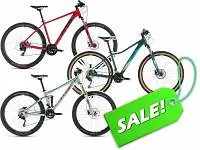
Massive savings for off-road warriors!
Mountain Bikes are designed to be ridden exclusively off-road, and are divided into two main categories; Hardtails and Full Suspension.
Hardtails have a rigid frame, usually paired with a suspension fork, and a Full Suspension Mountain Bikes feature both front and rear suspension. A full suspension model will typically be both heavier and feature cheaper parts than a similarly priced hardtail - this is to compensate for the extra costs of both manufacturing the frame and supplying a rear shock.
Hardtail Mountain Bikes
There are several styles of hardtails, all of which feature different geometry and excel at their own genre of riding. This should be your first consideration; what kind of riding do I wish do?
If you're into heavy duty riding with large jumps, and aren't that bothered about riding fast uphill, then you'll want a tough dirt jump hardtail, with a small frame and relaxed geometry.
Prefer shredding trails? A trail riding hardtail with a longer travel suspension fork will be ideal.
However, if you're a budding cross country (XC) racer and need to ascend at speed, then you'll be looking for a lightweight XC hardtail. These aren't suitable for big drops or jumps, but will be the quickest bike on a closed loop circuit.
Full Suspension MTBs
As per hardtails, full suspension steeds are also divided into a few different types based upon their intended use.
- Pure Downhill (DH) Bikes - as the name suggests, these are exclusively used for riding fast downhill, with long travel suspension and built to be abused.
- Enduro Bike - a lighter and shorter travel version of the above, which also handles non downhill trails more efficiently.
- Trail Bikes - a versatile bike, which will handle most riding.
- XC Bikes - as per the hardtail description above, these are lightweight bikes designed exclusively for riding fast up and downhill.
Getting the right tool for the job is essential; a lightweight carbon MTB will not necessarily cope with the punishment of large jumps and downhill courses. Equally, a heavy duty jump bike or full suspension downhill rig won't be capable of climbing fast.
As a rough guide, downhill and enduro bikes will be heavier and feature longer travel suspension, with lightweight XC bikes having short travel suspension, often fitted with lockouts as to not waste energy when riding uphill.
If in doubt, please read forums and reviews, ask fellow riders and retailers, and watch YouTube videos prior to purchasing, to establish the most suitable model for your weight and riding style.
Once you've decided on a style, you will then have two further choices: frame material and wheel size.
Frame Material
Entry level MTBs frames are typically made from alloy (aluminium), with carbon being reserved for the more expensive models. As per road frames, a few steel and titanium models are also available, although these are a minority. I've outlined the pros and cons of each of these materials in my Road Bikes section above, so I won't repeat myself here.
MTB Wheel Size
Older MTBs used to feature 26" diameter wheels as standard, although in the last decade these have been superseded by 27.5" (650b) and 29" sizes. Generally speaking, the larger sized wheels are slightly heavier and slower to accelerate, but roll over trail obstacles more effectively. Whichever you choose, please ensure that both the frame and fork have plenty of tyre clearance to run your choice of tyres.
Brakes
Braking duties will be handled by disc brakes. In the past V brakes were popular, but discs are now standard on virtually all MTBs. Some cheaper models will have mechanical (cable operated) brakes, but the majority will feature superior hydraulic systems.
Groupsets
In the past, most MTBs featured a triple chainset (3 rings at the front), but these have been phased out in favour of a single or double chainring. Bikes with a single ring won't require a front shifter nor derailleur for simplicity, but will probably not offer the same range of gearing as a double or triple system. The majority of drivetrains and derailleurs will be manufactured by either Shimano or SRAM, and similar to road bikes, the specification will be determined by the cost of the bike.
Finishing Kit
The majority of cheaper MTBs will be kitted out with their own brand finishing kit (stems, handlebars, saddles etc), which will usually be slightly heavier but perfectly usable. These can all be upgraded at a later date, and so shouldn't be a major factor when deciding on a new bike. Higher end bikes will include brand name parts, with the lighter MTBs often including carbon fibre components. Dropper seatpost are a popular choice amongst riders, which enable you to raise and lower your saddle to suit the terrain. These will be included as standard on many high end bikes, but won't be included on the cheaper models.
Pedals
As with most bikes, pedals won't be included, and so you will have factor in this additional expense. The main choices are flat platform pedals, with grippy pins used with regular cycling footwear, or clipless pedals into which dedicated cycling shoes will attach to via special cleats.
To summarise, aim for the Mountain Bike that:
- Is suitable for your riding style and weight
- Has the best frame and fork in your budget
- Has your preferred wheel size
- Features suitable gearing for your riding (single/double/triple chainring)
This will be a great platform to start from, and the rest can be upgraded later on, once you realise what works for you.
Gravel Bikes
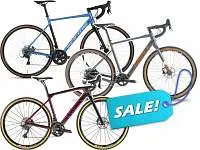
Savings on Speedy Versatile Bikes
Gravel bikes are essentially a do-it-all bike, designed to be equally comfortable off-road as on the tarmac. Characterised by road bike size wheels, paired with wider tyres and drop bars, gravel bikes have firmly established themselves as a popular choice among UK riders. Versatility is their main selling point; fast enough on the smooth stuff for long road rides, but also burly enough to handle speedy singletrack on off-road excursions. Similar to cyclo-cross bikes, essentially gravel riding fills the void left by old school hardtail mountain bikes, which were designed to be ridden not only offroad, but also to and from the trails.
Gravel Bikes are divided into two main camps; race bikes and adventure bikes, with race models being lighter and faster, and adventure prioritising comfortable, handling and durability.
So how do they differ from a road bike?
The vast majority of gravel bikes feature disc brakes, compared to around half of road bike models. Geometry is slightly more relaxed, and overall the bike is built to take a bit more punishment associated with singletrack. A longer wheelbase, slacker head angle and slightly raised steering on the gravel model are the major differences between the two.
Tyre clearance on a gravel bike is far larger than a road bike, as they are designed for both wider tyres and also handling the great British mud. The tyres themselves are slightly knobbly to provide grip without gaining rolling resistance; they're usually run at considerably lower pressure than their road equivalents to increase grip levels further still. Tubeless is a popular choice in gravel ranges, due to the increased likelihood of punctures.
There's a lean towards gravel bikes featuring a single chainring up front, and consequently no front derailleur nor shifter, although there are still numerous double chainring models on the market. Chainrings are smaller and Gear ratios lower than their road equivalents, to cater for the lower average speeds and bumpy climbs that a gravel bike will tackle.
A few high end models provide suspension, although the vast majority of ranges are rigid. As per all other forms of bike, cheaper gravel bikes tend to feature an alloy frame - such as the entry level Merlin Malt G2 Claris, with carbon reserved for the more costly models. Being the "Touring Bike" of the gravel world, some adventure bikes feature premium steel framesets as well.
So there you have it - an incredibly versatile bike, which isn't as fast as a dedicated road bike, nor able to handle rough technical terrain as comfortably as a mountain bike; a high performing jack of all trades bike, which gives you freedom to ride wherever you wish. Ideal for those with room for only one bike.
Hybrids / City Bikes
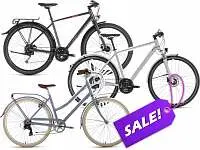
Cheap Commuting Cycles!
Hybrids, or city bikes as they are alternatively known, are designed to be ridden mainly on the roads, with the occasional gentle off-road section thrown in (think canal paths rather than technical trails!). They consist of a rigid frame paired with either rigid or short travel suspension forks, and usually a set of flat or curved handlebars.
So what's their purpose?
They're ideal for the casual cyclist looking to ride or commute relatively short distances, with tyres and components capable of handling the odd bridleway in addition to road. Slower than a road bike, and less suitable for bumpy off-road riding than a Mountain Bike, Hybrids provide more relaxed geometry than a gravel bike, complete with wider bars for extra control.
City Bikes vary massively depending on their target market and rider budget, with cheap but heavy models starting at £200 ranging up to a handful of expensive lightweight carbon framed models. As such, it's difficult to describe a typical hybrid due to the variations in purpose and design. The majority feature alloy frames and are built with comfort and durability in mind, with weight and speed very much a secondary consideration.
Wheel sizes vary from 26" to 700c, and lower end models often feature a dropped cross bar on ladies models. Brakes are a mixture of calipers, disc and coaster brakes, and the majority of frames feature mounts for both mudguards and rack mounts.
If you're a beginner or casual cyclist, looking for a reliable, low maintenance bike for relatively short journeys, then a hybrid could be the bike for you.
Folding Commuter Bikes
Bikes that Fold up for easy transportation and storage!
As the name suggests, folding bikes can be hastily folded into a convenient suitcase sized shape for commuting with, thus ensuring easy transitions between riding and public transport. Granted, you can take regular bikes on the train, but rarely on buses and the underground. A bike that folds can travel on virtually all public transport, and eliminates the need to leave your precious bike locked at the station at risk of theft, vandalism and exposed to the elements.
Folding bikes typically have 16" to 24" wheels, with a single front chainring combined with either internal rear gearing, or a standard cassette and rear derailleur. A notable feature of folding city bikes is the relatively small frame and fork, with an extra long seatpost and stem enabling taller riders to cycle comfortably. Folding (and unfolding) these bikes are typically carried out via a series of hinges and quick release levers, the placement of which vary depending on the make and model purchased.
The main advantage of a folding hybrid bike is the relatively small amount room required for storage, making an ideal model for both those with limited space at home, or people wanting to part cycle their commute. The risk of theft is reduced, as are your travel costs.
The disadvantages are that folding bikes are not as suitable for long periods of cycling as a traditional bike. Smaller diameter wheels will struggle with cycling on bumpy or uneven surfaces. Folding bikes are designed to resize into a convenient and lightweight package, and component choices are slightly compromised as a result. Narrow bars and the unusual riding position with a small frame may not be comfortable for some, and cycling up challenging inclines may also be too tricky due to the limited gearing.
For their purpose of easy storage and travelling on buses, planes, tubes and trains, folding bikes excel. However if you plan to ride one for long journeys like as your regular bike, you would be better suited looking for a non folding regular sized model with larger wheels.
Electric Bikes
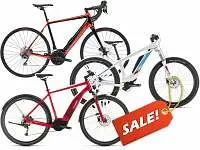
Battery Assisted Bargains!
My electric bikes (e-bikes) section features a wide variety of bikes, all of which offer battery assistance to take the strain from your legs. Electric versions exist for most of the bike types outlined on this page, and so vary from light road e-bikes, with a slightly enlarged downtube, to heavy duty full suspension MTBs that more resemble motorbikes. All require charging prior to use, and the motors are limited to 25 km/hr so as not to exceed the UK speed limit.
In terms of design and finishing kit, an electric bike is very similar to the non-electric version, albeit heavier and with a bulkier frame to house the motor and battery. These mechanical additions also increase the price somewhat, due to the cost of the extra equipment. Typically electric bikes start at around £1000, so they're a significant investment, but one that can improve people's quality of life.
So who are E-Bikes aimed at?
Riders who either can't or don't wish to pedal up hills, but still wish to experience the fun of cycling. Electric Bikes enable people to get fresh air, partake in gentle exercise and travel to areas previously inaccessible to them on a regular bicycle.
My electric bikes section typically has a wide range of e-bikes, from the basic hybrids models to sleek looking road bikes and burly E-MTBs. As per the rest of my website, I can only list the deals I find, so at times it may be a little sparse. To decide which type of E-Bike is best for you, simply read through the various bike sections on this page and establish which style of riding suits you best.
It stands to reason that E-bikes are more likely to encounter issues after sales when compared to regular bicycles, largely due to the additional technology built in. More moving parts equals more to potentially go wrong! For this reason, it's vital to read unbiased reviews of the bike itself (including the motor and battery), it's manufacturer and the retailer to avoid warranty issues further down the road.
Track / Fixie Bikes
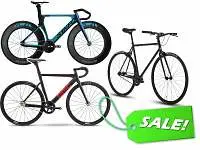
Fantastic Deals on Fixies!
Track Bikes are simplicity itself; 1 single gear, a fixed wheel and no proper brakes. Originally designed for the velodrome, fixies have becomes increasingly popular as a mode of transport in the urban environment. In real world conditions, track bikes aren't as versatile as other bikes, as their lack of gearing and front brakes makes climbing and descending hills somewhat harder. Part of the appeal is the uncluttered clean lines of this bike, with no additional chainrings, derailleurs, shifters, brake calipers, cables nor levers; a simple single chainring and sprocket are all that remain.
The fixed wheel means that you can't freewheel; you have to constantly pedal whilst travelling, otherwise the rear wheel will lock. This is the braking technique for track style bikes, and for riders used to regular freewheel equipped bikes, it will take some getting used to.
Fixies have a cult like following amongst UK cyclists, particularly in cities. The simplicity of the singlespeed drivetrain and lack of regular brakes results in far less mechanicals. As a result, many bike couriers use a fixe as their weapon of choice. Like them, you'll need to develop powerful thigh muscles in order to regularly accelerate from a stationary position.
By UK law, a bike must have two working brakes to be ridden on public roads. As a consequence, some models are sold as strictly for track use only. In other cases a front brake is fitted, which users can choose to remove at their own risk.
My track bike section isn't the most populated page of this website, primarily as fixed gear bikes aren't as frequently sold as other models; as a result there are fewer on the market, and consequently not as many deals. I strive to add all the fixies I can find, so hopefully there will be something there for you.


